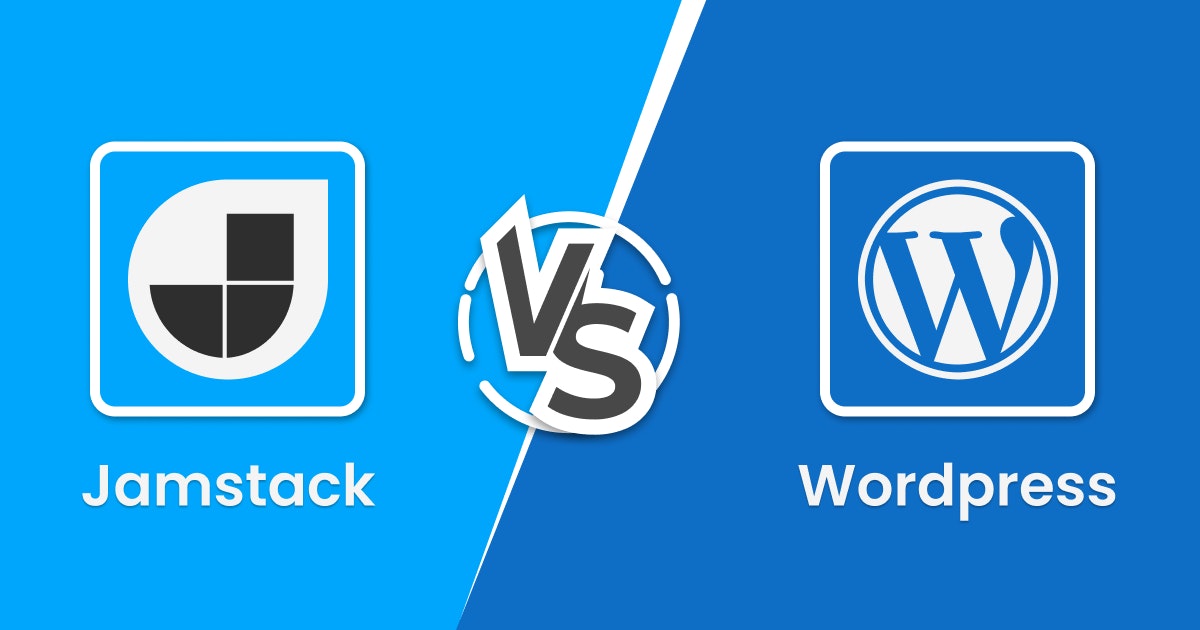Have you ever wondered how much time goes into developing and managing a typical web application infrastructure? For a long time, that was considered a highly complicated process, and for a good reason.
The technologies used for making websites and mobile apps would quickly become irrelevant. A modern code refactoring in programming was required. That is where WordPress and JAMstack enter the picture.
While WordPress is a platform for building sites, JAMstack is a web development architecture. It is an impressive ecosystem of tools that help developers build high-performing and more secure sites, PWAs, and other applications.
Today, 43% of sites in the world are made on WordPress. It is the most popular CMS in the market, covering 60.8% share. Moreover, the WordPress plugin directory has 59,674+ plugins.
On the other hand, JAMstack powers 0.9% of all web pages, including 0.91% on desktop and 0.84% on mobile. A Kentico survey revealed that 54% of developers are familiar with JAMstack, and 64% have already worked with it.
Comparing JAMstack and WordPress is like comparing apples and oranges. The foundation they are built on is different even though they fulfill one purpose, i.e., building sites. So, what is a better choice to include in your next software development practices? Let us find out:
JAMstack
It is a web development architecture that develops a website statistically, moving away from static hosting to HTML. JAMstack’s concept was conceived to eliminate the negative stigmas associated with “static.” Basically, JAMstack offers dynamic content and an interactive user experience via JavaScript.
MailChimp, Red Bull, and Sequoia Capital were the first few enterprises to build JAMstack projects. JAMstack has generated considerable investor interest in the last four years because it can produce more mature solutions than any other framework in the market.
Features of JAMstack
The word “JAM” in JAMstack stands for JavaScript, APIs, and Markup. Combining the three technologies enables developers to build sites and mobile apps quickly.
Plus, they can build apps in their preferred environments. All the changes made to web pages are deployed on the CDN in real-time. Here are the top features that make the JAM:
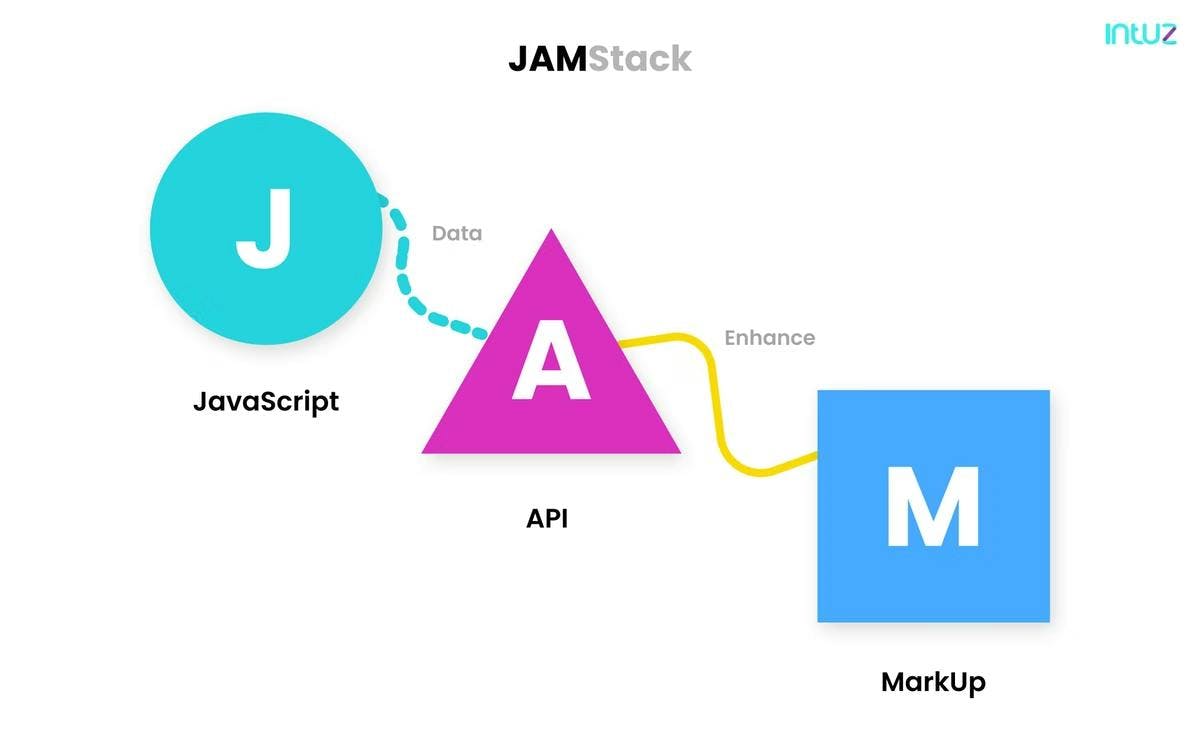
1. JavaScript
JAMstack apps are dynamic because of the JavaScript that runs on the users’ browsers. Besides, with the rise of Single Page Application (SPA) architectures, frontend developers can simulate multi-page apps without leveraging a web server.
2. API services
Through APIs, data is requested or fetched from other programs or apps. These are connected with all static apps via AJAX requests that enhance the features of a JAMstack application. Companies such as Snipcart, Hasura, and Auth0 offer API-based services.
3. CDN
JAMstack sites are served through a Content Delivery Network (CDN) because they only comprise static assets. That is what makes them faster and more efficient — a perfect choice for websites.
4. Static pages
Most developers do not want to write apps in HTML. That is why static site generators or SSGs are deployed. No wonder JAMstack apps only contain pre-rendered static pages.
Advantages of JAMstack
No business can do without a website in this day and age. Building one that stands the test of time is, therefore, necessary. JAMstack brings many benefits to the table, including:
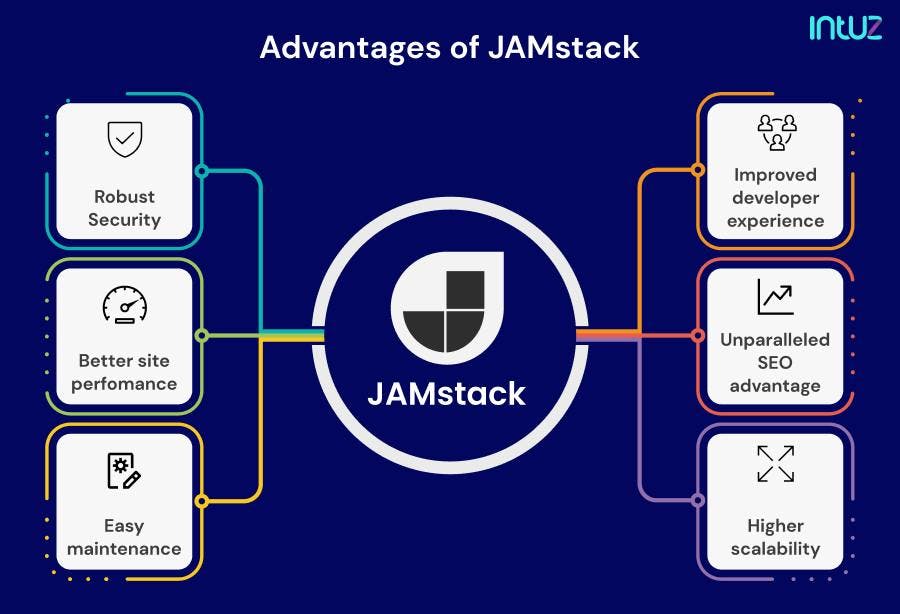
1. Robust security
In JAMstack, the frontend and backend architectures are decoupled, and you can depend on API services to run server-side processes. The arrangement makes it difficult to find individual vulnerabilities. Plus, there are fewer entry points of attack. That is why JAMstack is more secure.
2. Better site performance
Since the pre-built static files are directly hosted from CDN, the JAMstack-powered websites load quickly and can easily handle traffic spikes — without negatively impacting the user experience. That is what makes JAMstack ideal for enterprise-grade sites.
3. Easy maintenance
JAMstack taps into the full potential of frontend technologies instead of managing the site infrastructure directly. The architecture, therefore, requires low maintenance, plugins, hosting servers, and databases, enabling you to save more.
4. Improved developer experience
Sure, user experience is essential. But developers should also enjoy the web app development process. Thankfully, JAMstack enables local development environments with the ability to run and debug cloud functions locally. One can also apply business logic successfully.
5. Unparalleled SEO advantage
Ranking high on search engines is a high priority for all business websites. It helps if the foundation on which the sites are being developed provides built-in SEO qualities. With JAMstack, you do not need to worry about indexing static pre-rendered web pages, as Google bots manage that. This leads to a fantastic user experience and higher engagements.
6. Higher scalability
As a business grows, it might want to scale up its site. However, if it is built on HTML, that can be challenging. JAMstack-powered sites use CDNs for hosting, and that makes them infinitely scalable. CDN hosting for static files is more cost-effective compared to traditional hosting.
Cons of using JAMstack
JAMstack offers a range of benefits that the usual website builders like WordPress or Square do not. However, that does not mean that it does not have any disadvantages:
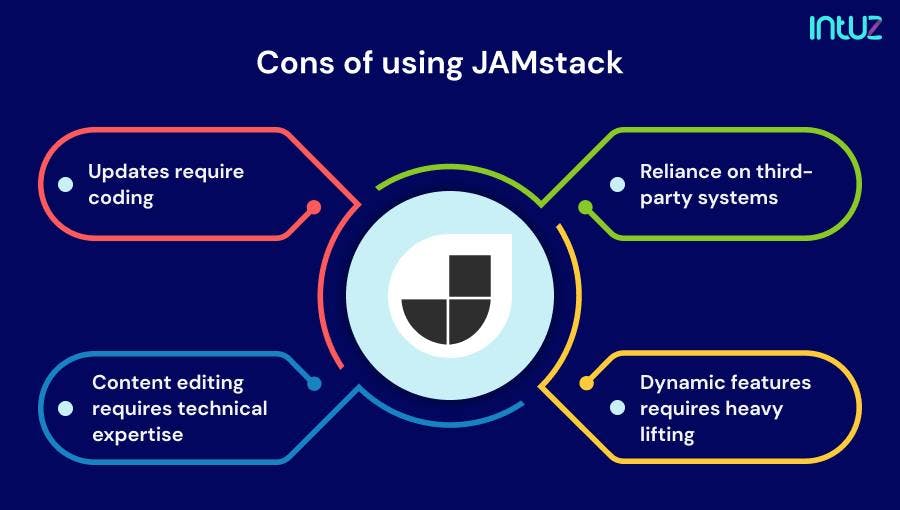
1. Updates require coding
If you want to update any templates on JAMstack, you will need to do them via coding. Because the content is decoupled from the frontend, there is no way you can use your editor to customize the templates. You have to modify the codebase.
2. Content editing demands technical expertise
Developers love JAMstack, but one cannot say the same about marketers and content editors, as using the architecture requires technological knowledge. This acts as a roadblock to content production as non-technical team members need time to access a JAMstack site, and they may still not be fully equipped to use all editor features flawlessly.
3. Reliance on third-party systems
Because JAMstack uses a set of tools (such as APIs and plugins) to set up a site, if one of them goes down, so does the site or at least some parts.
4. Dynamic features require heavy lifting
JAMstack is an attractive option as long as you develop pages with text and images. As soon as you move towards a more dynamic aspect of the site, you will likely run into issues. Without a database for request processing, you will need to do more heavy lifting with your code or API calls.
Examples of sites built on JAMstack
Several brands have built their web presence with JAMstack and benefited from the decision. Some famous names include Peloton, TakeShape.io, Louis Vuitton, Ingmarson, JFK Terminal 4, Fabuwood, and Logger MTS.
Who is JAMstack ideal for?
Whether you are an agency or eCommerce site, belong to education, government, and media domains, or run a nonprofit or travel site, JAMstack is ideal for you. Each industry niche has many growth opportunities, and with that comes the desire for a scalable and robust site.
JAMstack alternatives
What do you do if JAMstack is not what you are looking for? Sure, WordPress is a fantastic option. But what if you want to achieve similar SEO results and be able to edit your content on your CMS conveniently? There has to be another option, right?
Yes, of course! Squarespace, Weebly, Webflow, Wix, and Shopify are excellent website builders that do not require much technical expertise to set up a site. On the other hand, you can look at options like MERN, SPA, and React, on which you can build a site from scratch.
WordPress
Think uploading blogs, and it is not difficult to think of WordPress first. Even before Squarespace, Ghost, and Wix became popular, it was WordPress that was popular among the newly-formed and upcoming digital marketing teams.
As 43% of websites in the world are powered by WordPress, this does not come across as a surprise. WordPress is an open-source and free content management system (CMS) written in PHP and can be paired with a MariaDB or MySQL database.
Launched in 2003, it features a robust plugin architecture and an excellent template system, the reason behind WordPress themes. Pricing depends on individual and business requirements.
Features of WordPress
WordPress is a powerhouse when it comes to CMS. But it has slowly evolved to be so much more in this day and age. Come, let us take a look at the various features it brings to the table:
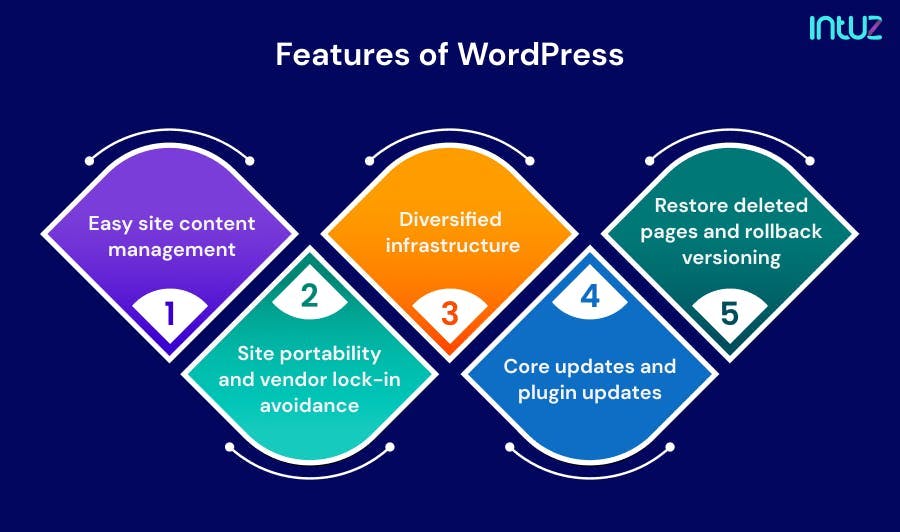
1. Easy site content management
With its intuitive admin panel, you can log in from any modern browser and change your website content without applying any programming or technical knowledge.
2. Site portability and vendor lock-in avoidance
Because WordPress is an open-source platform, the websites function in a compatible environment and are not tied to any one vendor. WordPress CMS platforms can lead to a complete project restart if the CMS developer stops offering support or the need for migration arises.
3. Diversified infrastructure
Due to an intuitive foundation, the WordPress website runs on a node dedicated solely to your website, while mail, DNS, and other services operate on nodes optimized for their environments.
4. Restore deleted pages and rollback versioning
You can quickly restore deleted pages before they get deleted forever from the WordPress server and roll back page text to previous versions using built-in version control. Save and hide pages that are important but not required on the site currently.
5. Core upgrades and plugin updates
WordPress is proactive when applying updates and core upgrades to every WordPress CMS ongoing. This helps keep all the sites on a stable development track so that the site owners do not have to worry about scheduling the upgrades themselves.
Advantages of WordPress
One of the main conceptions about WordPress is that it is only for building blog sites. However, that is not the case. It has many pros, including:
1. Adaptable to any site requirement
You can create full-fledged websites for SaaS, eCommerce, not-for-profit, travel, and so on. No industry has not benefited from what WordPress offers. That is the beauty of this website builder. You can either get started for free using its cloud solution or host the site on your servers by paying a recurring license fee.
2. Support for numerous media types
Expect to download files in common files such as .png, .gif, .doc, .mp3, .mov, and .wmv along with .odt, .ogg, and .key. Basically, WordPress can handle images, audio, video, and documents in any format, so you never have to worry about that bit. It is also common to host slide decks and documents on a website without publishing them on a specific page.
3. Easy to learn with a huge community
The user base of WordPress is not limited to its pricing, customer service, or even skill level. Anyone can learn the basics quickly and get started on it. The user interface of WordPress is easy and convenient, and you can explore different aspects of the admin panel on your own.
Besides, you can always access WordPress-run blogs, forums, online seminars, and webinars to gain all the knowledge you need to run your WordPress site properly. Besides, take the help of the customer service representatives.
4. Manage your WordPress site with ease
From ensuring the server is OK and keeping checks on security to running backups and testing for content management functionality and broken links to making improvements in site speed and SEO, there is so much you can do from the backend itself. It does not take a genius to manage WordPress.
5. Scale up or down with themes and plugins
You can install a theme for a standard WordPress blog, customize the design, and start blogging. The same approach can be applied to setting up websites or portfolios. Choose from 59,000+ plugins and empower your site however you like. Some are free, while others you have to pay for. But you will find a plugin for every purpose.
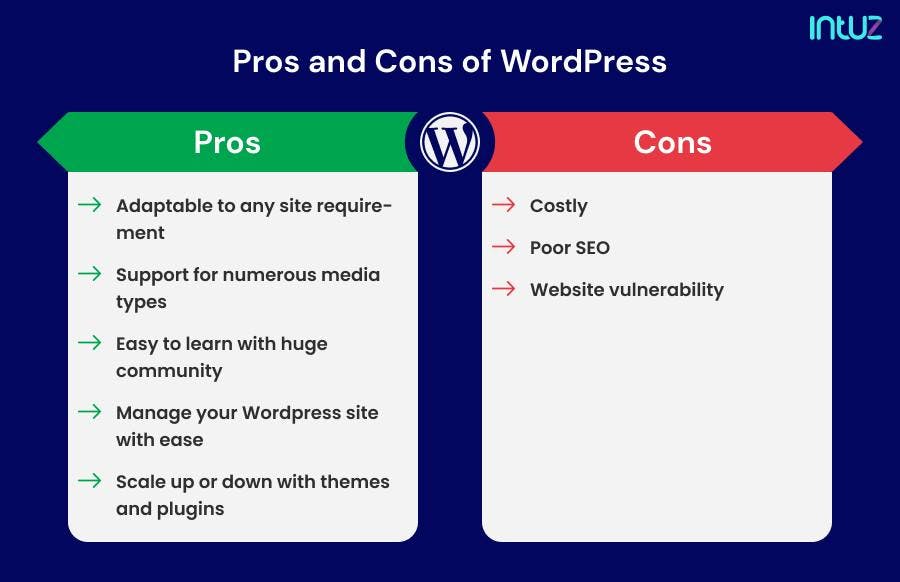
Cons of using WordPress
It is evident that WordPress has many advantages. It is truly a fantastic platform that all businesses love using. However, it is not free from many drawbacks, such as:
1. Costly
While the WordPress platform is free, tapping into its full potential requires customizable themes and paid plugins. The more you use them, the higher the cost of maintaining the site. That is not ideal for every business.
2. Poor SEO
WordPress only offers the introductory provisions for setting up SEO. On the platform, if the content is categorized under many options or over-tagged, Google can flag it as duplicate content. This can negatively affect your site’s rankings on SERPs.
3. Website vulnerability
Security is still a challenge in WordPress despite it being the most widely used CMS in the world. Poor security is because of its heavy reliance on plugins developed by different companies and individuals. That increases the risk of malicious code slipping through your site’s core functionalities.
Is WordPress a Good platform For Your Ecommerce Business?
Learn NowExamples of sites built on WordPress
Do not be surprised when we tell you the official Star Wars blog, Sony Music, The New York Times, 10Web, BBC America, and TechCrunch are all made on WordPress!
Who is WordPress ideal for?
Many web developers prefer WordPress because it stores content and enables users to create and publish web pages hassle-free. You also do not need to worry about having a domain name or exceptional hosting service as that can be procured from WordPress itself.
WordPress is a fantastic choice for anyone who wants to start a blog, build an online retail store, create a membership site, sell online courses, or simply make a business website. It is one of the finest choices for content management systems.
JAMstack vs. WordPress: A comparative analysis
If you have decided that your next site will be built either on WordPress or JAMstack, and you need to choose between the two, fret not. Here is a detailed comparative analysis of the two technologies:
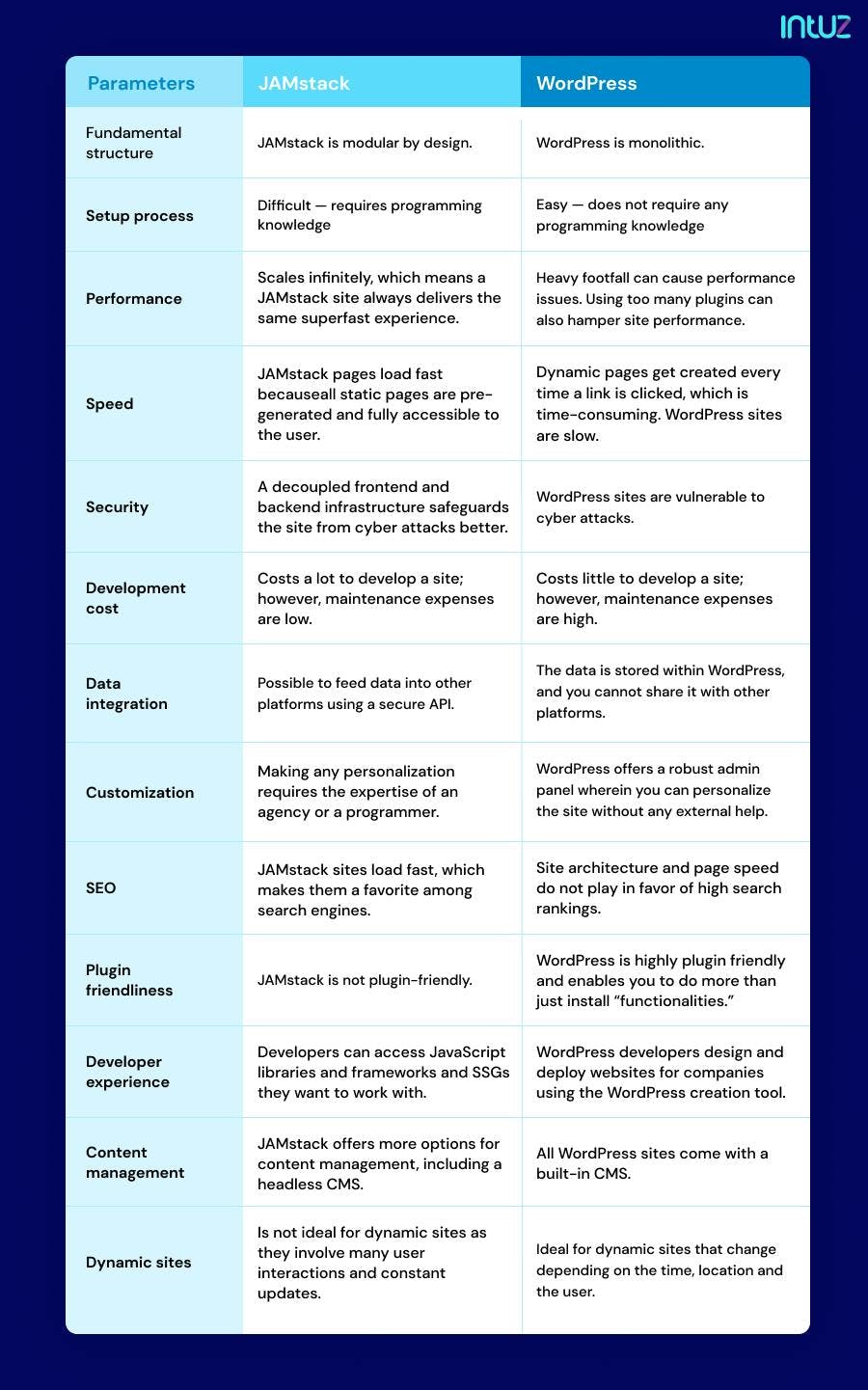
Over to you
WordPress is apt for small companies that want to launch their sites quickly — without the hassle of dealing with developers or agencies. Whereas JAMstack is perfect for those who wish for exceptional site speed, performance, and SEO and have the budget to get one site developed.
Just keep in mind — whatever you choose depends on your specific business requirements and objectives. You also need to consider your budget and ensure your overhead and human resource expenses stay within the limit.
If you are having a hard time deciding between the two, please contact us, and we will help you make the right decision. Our team has worked on numerous WordPress and JAMstack projects before and knows what it takes to set up a site that stands the test of time. Speak soon!
